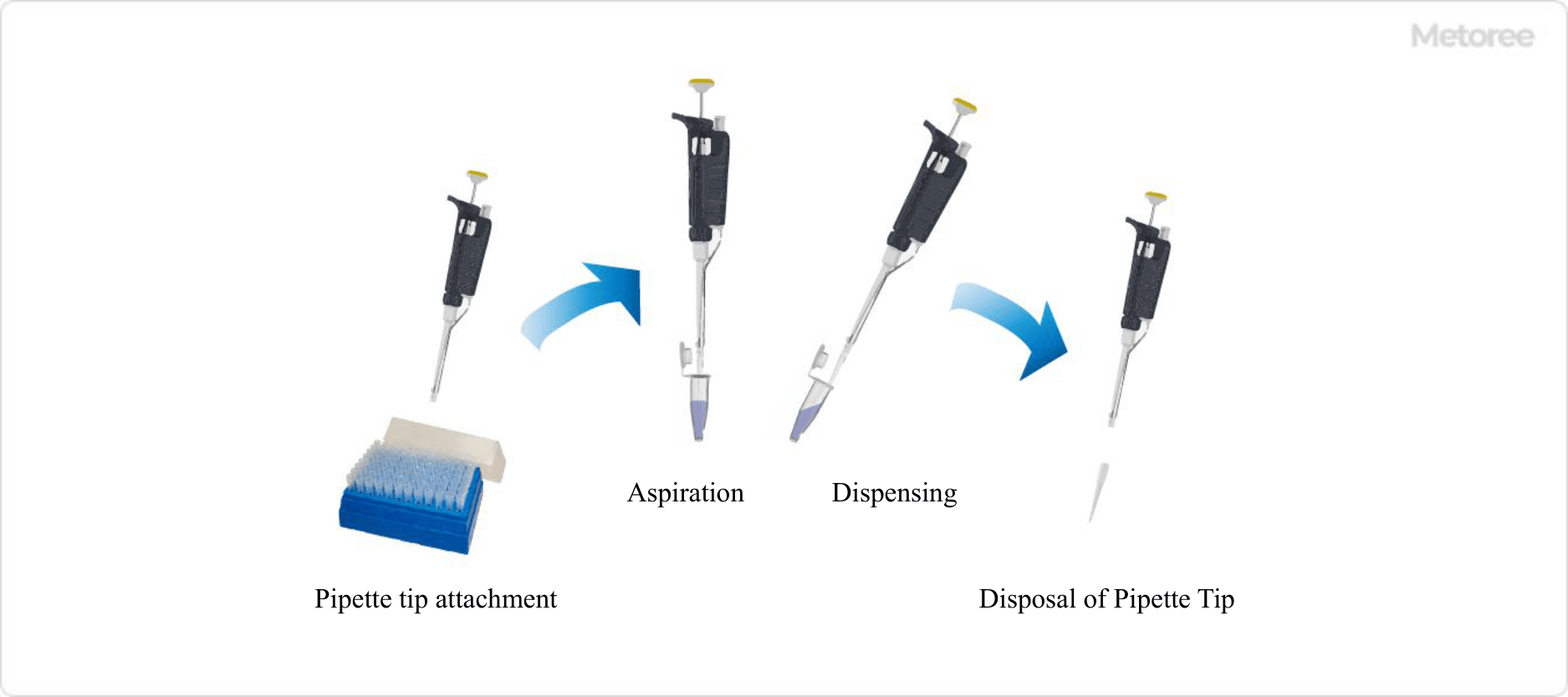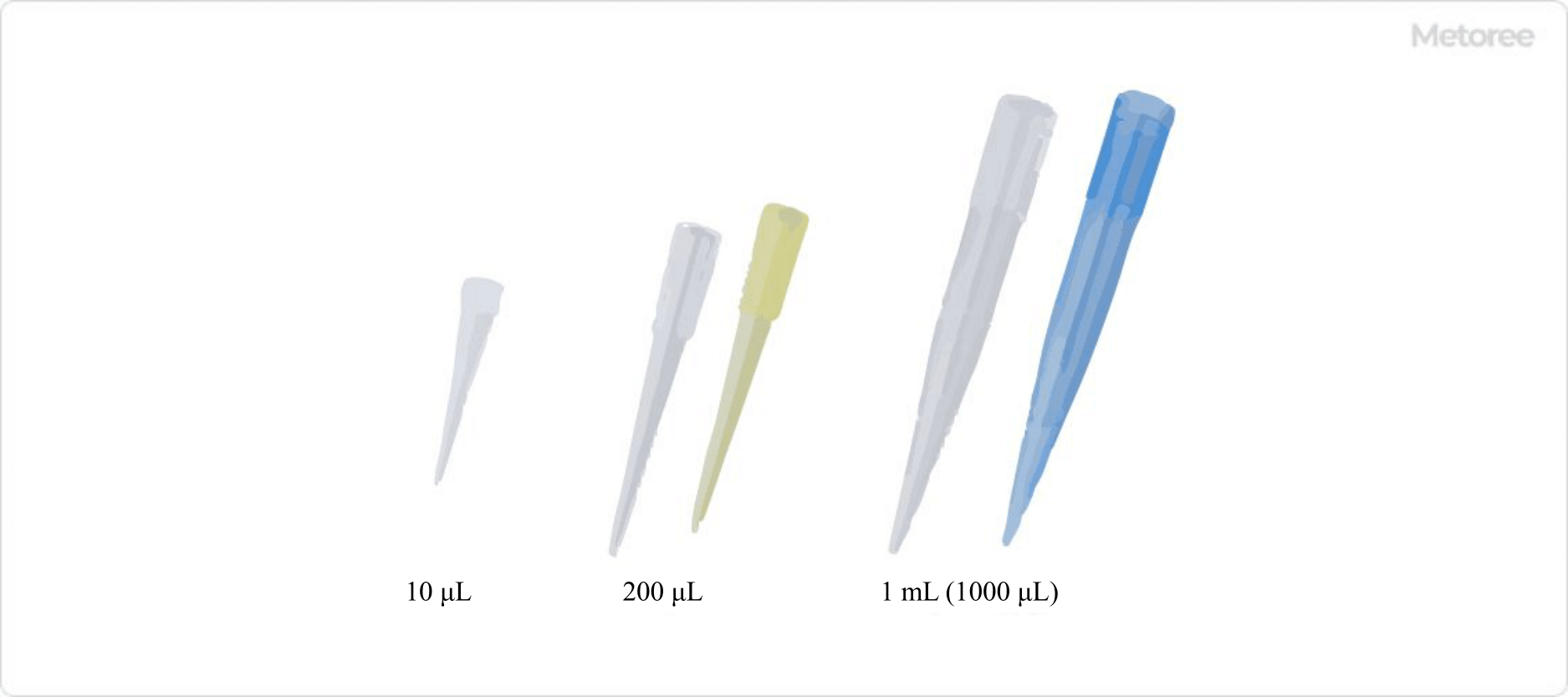What Is a Pipette Tip?

Figure 1. Image of pipette tip
A Pipette Tip is a plastic conical tube attached to a micropipette.
Pipette tips are used for measuring solutions in the order of μL to mL in research, development, and quality control in the chemical, biological, and other fields. This operation of measuring solutions by aspiration and ejection of a pipette is called pipetting.
Different sizes of pipettes are available, and the color of the pipette may vary depending on the size. To prevent contamination, pipettes should be stored in dedicated racks and discarded once used.
Uses of Pipette Tip
Pipette Tips are attached to micropipettes and used in all fields related to chemistry and biology.
Specific uses include laboratory experiments in the field of biochemistry, quality control at pharmaceutical manufacturers, and specimen collection in clinical testing. Micropipettes are used for handling minute amounts of liquids ranging from µL to several mL.
Although it is possible to quickly collect a fixed amount of liquid by simply pressing a button, it requires more care in operation than a glass volumetric analyzer because the volume tends to change more easily than a glass volumetric analyzer.
Principle of Pipette Tip

Figure 2. How to use pipette tips
The Pipette Tip is attached by filling the special rack for the pipette tip and directly inserting the tip of the micropipette.
Aspirate the liquid by slowly pushing the push button of the micropipette to the first stage, and when dispensing, push the button to the second stage to dispense the entire amount. To dispose of the pipette tip after use, simply push the ejector button.
Since there is no need to touch the pipette tip by hand, contamination of the sample and chemicals on the operator can be prevented.
Types of Pipette Tip

Figure 3. Various pipette tips
The capacities of pipette tip mainly used are 10 µL, 200 µL, and 1000 µL. Other types include 250 µL and 30 µL, and larger 5 mL and 10 mL pipette tips are also available.
Pipette Tips are available in several sizes, so it is important to select the appropriate size micropipette and pipette tip according to the volume of liquid to be measured. Specifically, the maximum volume that can be weighed out by the micropipette should be close to the volume of the liquid to be weighed out. This is important to minimize the error of the liquid volume.
Other Information on Pipette Tips
Points to Keep In Mind When Using Pipette Tips
For accurate measurement with pipette tips, the following points should be noted:
1. Pre-rinsing
Pipette Tips are made of a material that may absorb solution components on its inner wall. It is effective to aspirate and dispense the liquid to be weighed at least twice and pre-rinse the pipette before use.
2. Tip angle of penetration
The angle of entry of the tip should be as close to 90 degrees to the liquid surface as possible. It is appropriate to maintain within 20 degrees of vertical. If the pipette is held at an angle close to horizontal, an excessive amount of liquid may be aspirated.
3. Tip immersion depth
It is known that if the tip is immersed too deeply, the gas inside the tip is compressed and too much liquid is aspirated. It is appropriate to immerse the tip at a depth of 1 to 2 mm for a micro volume pipette tip and at a maximum of 3 to 6 mm for a normal volume pipette tip.
4. Proper pipetting motion
First of all, when aspirating liquid, care should be taken to raise the finger slowly without abruptly releasing it from the button. The purpose is to minimize the difference in aspiration speed due to the difference in viscosity of the liquid, and also to prevent the pipette from being broken when the rapidly aspirated liquid enters the mechanical part of the pipettor.
When dispensing, even the last remaining droplet should be dispensed completely, so that it does not adhere to the tip of the tip. In particular, it is recommended that the tip tip be dispensed along the wall of the container.
When weighing liquids with low surface tension, such as organic solvents, it should be noted that the liquid may remain adhered to the outer wall. In some cases, it may be more appropriate to use a microneedle with a needle-like tip.